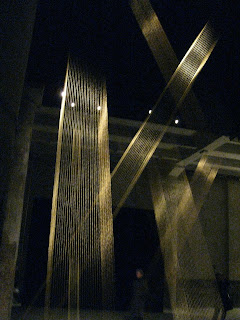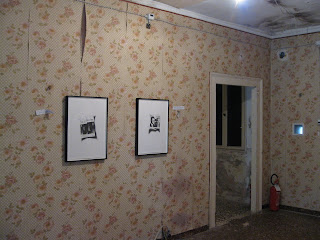 My first encounter with Catherine Hyde's work was a print of of ‘Between Earth and air’
My first encounter with Catherine Hyde's work was a print of of ‘Between Earth and air’The hare is a female symbol in fertility and the stag, which also makes frequent appearances in Catherine’s work, is her male counterpart.
 I recently heard Catherine speaking about her work at a Telling Tales study day at the V&A . It was particularly interesting to hear about her illustrations for The Princess Blankets by Carol Ann Duffy. The Oceans Blanket is shown above.
I recently heard Catherine speaking about her work at a Telling Tales study day at the V&A . It was particularly interesting to hear about her illustrations for The Princess Blankets by Carol Ann Duffy. The Oceans Blanket is shown above. She currently has an exhibition at the Lighthouse Gallery in Penzance. Much of the work is based on The Nine Powers by Robert Graves. My favourite piece from the exhibition is ‘Soft Night Descending’ a fabulous barn owl coming in to land or catching prey, depending on your sensibilities.
She currently has an exhibition at the Lighthouse Gallery in Penzance. Much of the work is based on The Nine Powers by Robert Graves. My favourite piece from the exhibition is ‘Soft Night Descending’ a fabulous barn owl coming in to land or catching prey, depending on your sensibilities. ‘The Barley River’ (right) is one of many paintings that focus on tension points where things such as land and water meet. The moon represents time, fullness and the female.
‘The Barley River’ (right) is one of many paintings that focus on tension points where things such as land and water meet. The moon represents time, fullness and the female.Another creature that often features in Catherine’s paintings is the crow which has a duality representing both ill omen and knowledge
The Nine Powers
Not of father nor of mother
Was my blood, was my body.
I was spell bound by Gwydion,
Prime enchanter of the Britons,
When he formed me from nine blossoms,
Nine buds of various kind:
From primrose of the mountain,
Broom, meadowsweet and cockle,
Together intertwined,
From the bean in its shade bearing
A white spectral army
Of earth, of earthly kind,
From blossoms of the nettle,
Oak, thorn and bashful chestnut
Nine powers of nine flowers,
Nine powers in me combined,
Nine buds of plant and tree.
Long and white are my fingers
As the ninth wave of the sea
By Robert Graves
By Robert Graves










 I have been looking at the work of
I have been looking at the work of 





















 Moving into the Enchanted Castle the focus becomes opulence and a sense of 'over the top' prevails. To the right the walls and floor are mirrored giving a sense of mad glitter and glamour (see above).
Moving into the Enchanted Castle the focus becomes opulence and a sense of 'over the top' prevails. To the right the walls and floor are mirrored giving a sense of mad glitter and glamour (see above). 


